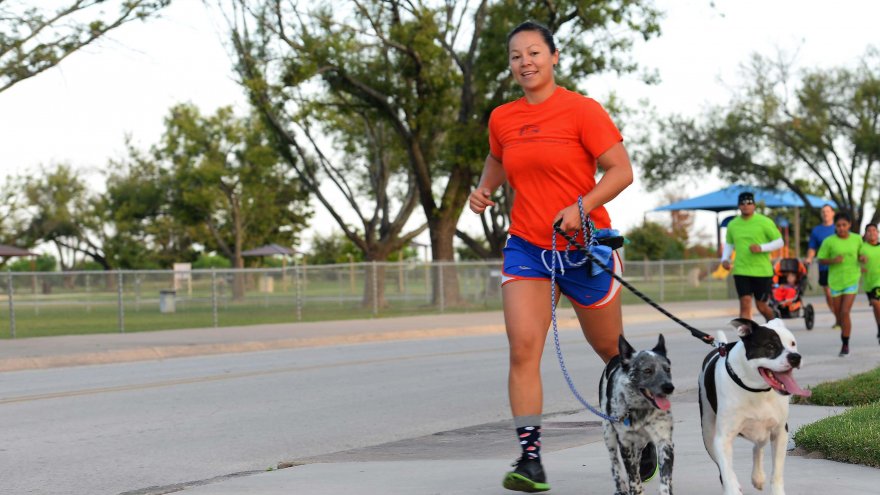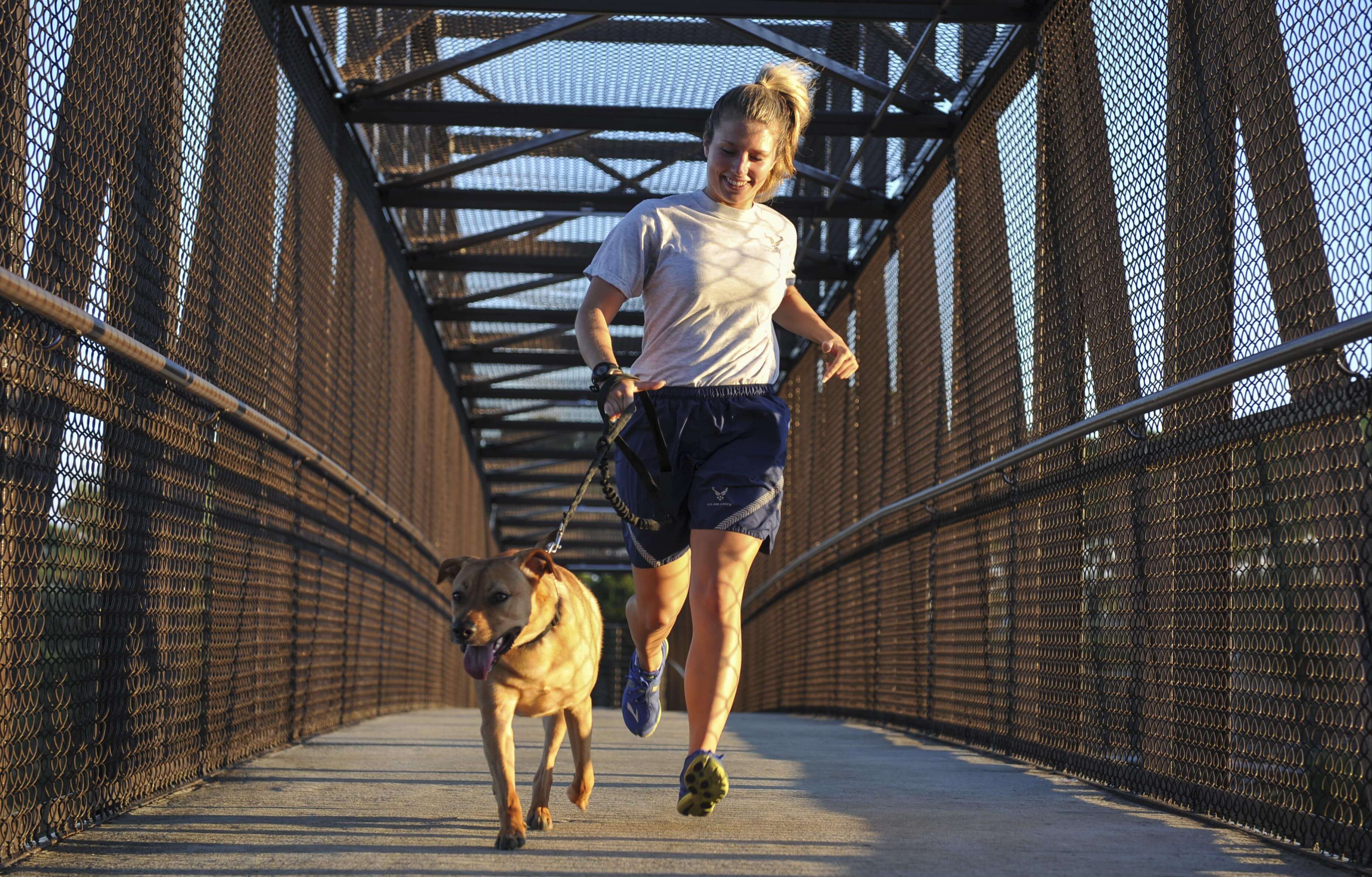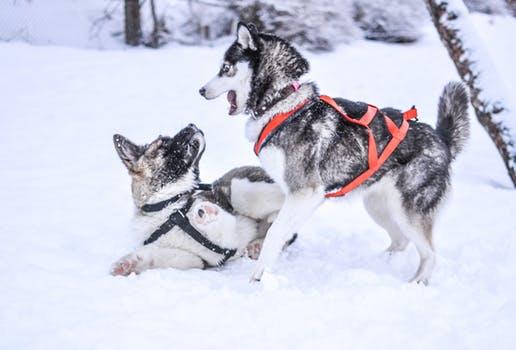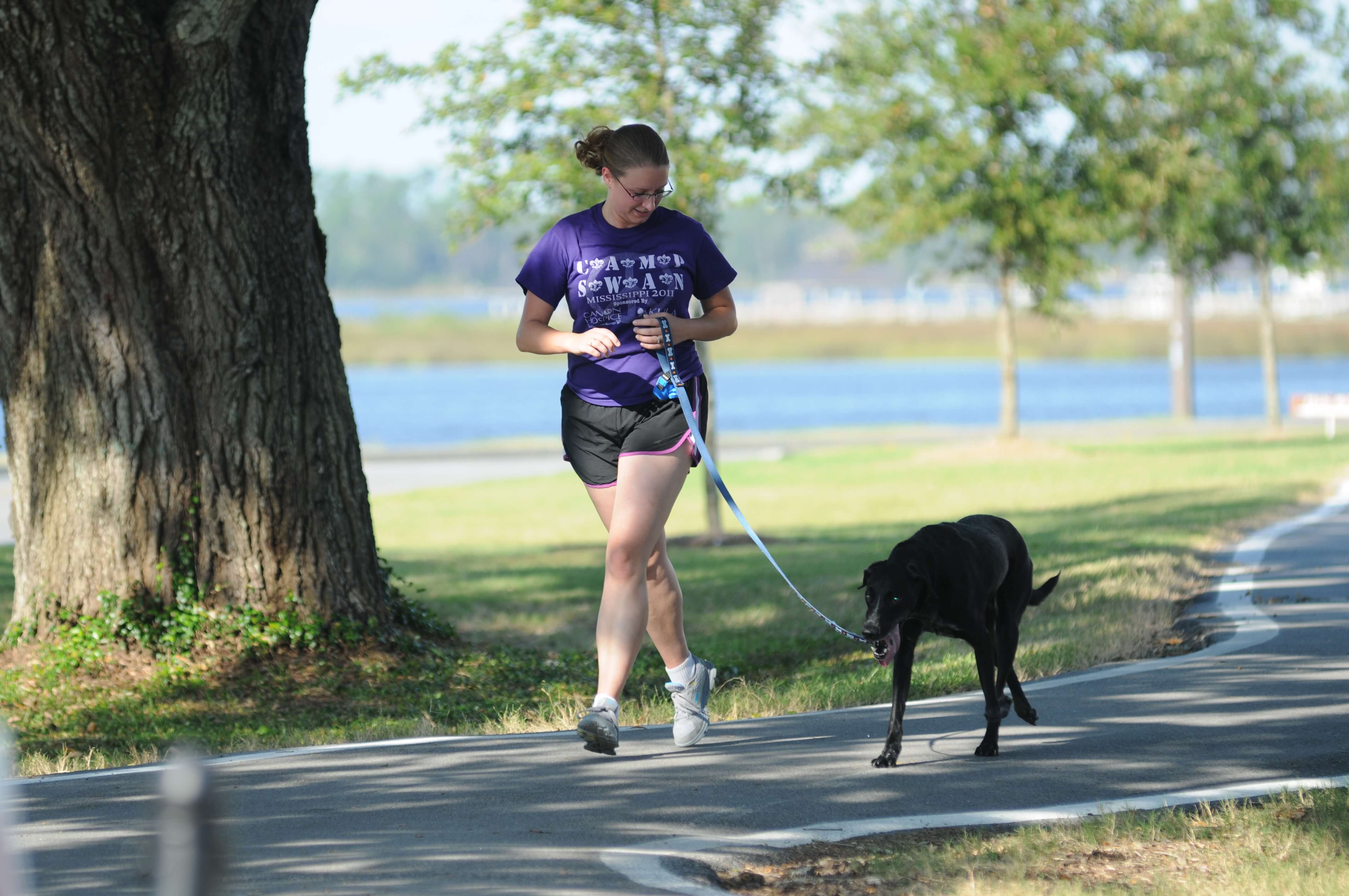Best Time to go Out and Run with Your Dog?

So many areas of the country have experienced colder than normal temperatures this winter, which begs the question – When is it too cold to run with your dog? Although we can layer up and of course you can put a sweater or jacket on your dog, you have no way of knowing how comfortable your dog really is on a cold run. On the other hand, when is it too hot?
Before You Run Together
If you have never taken your dog to a run before, there are a few things to consider. According to the American Kennel Club (AKC), certain breeds are best for running. This includes Alaskan Malamute, Whippet, Greyhound, Border Collie, Siberian Husky, German Wirehaired Pointer, Rhodesian Ridgeback, Vizsla, Dalmation, and the Labrador Retriever. If your dog’s breed isn’t on this list, however, it doesn’t mean he or she won’t be a great running companion for you to run with your dog but the AKC does make the following suggestions before including your dog in your training regimen.

Also, be sure to have your dog seen by a vet to make sure there are no underlying health issues that might prevent him/her from being a good running partner. Here are a few other things to consider before heading.
- Because continuous exercise may damage bones and joints during the critical growth process, it is best to hold off for a run with your dog until he/she is two years of age.
- Just as you might if you are starting a new exercise program, have your dog seen by a vet to make sure there are no underlying health issues that might prevent him/her from being a good running partner.
- Take it slow at first. Just as with people, going too fast and too far too early in a training program can lead to injuries. Build up gradually to longer distances.
- Allow ample time for your dog’s paws to toughen up. Developing callouses on the pads is important particularly if your dog will be running on pavement. Booties can protect dogs’ sensitive pads.
- Don’t forget to hydrate both for you and your dog. Because dogs don’t have sweat glands, carrying water for your dog while on a run is extremely important.
When Is It Too Cold?
Your dog’s breed is a good indicator of the weather they can withstand. Breeds like the Alaskan Malamute or the Siberian Husky that have thick fur are going to be right at home in the colder weather. Breeds with short hair, like the Dalmatian, Greyhound or Whippet, might require a coat or sweater during winter runs. If your dog does wear a sweater or coat, the American Veterinary Medical Association, or AVMA, suggests that owners make sure that there are no dangling straps that could become tangled in your dogs’ legs and that the sweater or coat doesn’t restrict breathing, hearing, sight or movement.

All dogs’ paws can be sensitive to cold, ice, snow and ice melting products. If your dog will tolerate wearing booties, they are a great way to protect the paws. If your dog refuses to wear booties, AVMA advises cleaning your dogs’ paws (including in between the toes) after every run to remove road salt or ice melt products. Also watch for signs of swelling, skin damage or pain which could indicate frostbite or other issues. Despite having a fur coat, dogs can get frostbite, most often on the tips of their ears and tail.
In addition to gearing up, it is important to pay attention to your dog’s behavior. On just a cold walk, my dog will stop and lift up her paw and sometimes even two alternating paws at once because her paws/pads are cold or even irritated by road salt. When I notice her doing this, I hurry home and make sure to clean and dry her paws afterward. If you notice your dog hobbling or limping when hitting on a cold run or slipping and sliding on snow or ice, it is probably time to cut your run short. You may not want to venture too far from home in nasty weather so that it is quicker to return if necessary.
Common sense prevails here. If you are dreading or are concerned about the run because of potentially dangerous weather, it is probably safer to have a recovery day for both you and your dog.
When Is It Too Hot?
Again, just as it is important to consider your dog’s breed when cold weather running, the same holds true for running in the heat. Those Siberian Huskies and Alaskan Malamutes are probably not great warm weather runners due to their thick fur.
The AVMA explains that a dog’s main way too cool down is through panting, which is not as efficient as a human’s sweating. And although dogs do have sweat glands in their paw pads, that isn’t the primary way they cool off. Because of this, dogs can become dehydrated just like people can. Make sure you and your dog have plenty of water before, during and after the run with your dog.

According to ASPCA, dogs also can develop heatstroke so watch your pet for labored breathing and excessive panting and stop your run if you notice any of these conditions. Your pet might require medical attention to treat a potential case of heatstroke.
In addition to being sensitive to cold, snow, ice and road salt/ice melt, dogs’ paw pads also can be sensitive to hot sidewalks and pavement. On very hot days, you might instead consider going to a run with your dog on a wooded trail or grassy surface.
During the spring and summer months, consider what will be the hottest part of the day and avoid running during those hours. And just as during cold weather, choosing a route that is close to home during the heat of spring and summer is wise in case you need to return quickly.
Precautionary measures and being in tune with your pet will ensure that you and your dog can enjoy a run with your dog together even when the weather isn’t ideal.
Sources
- , Hot Weather Tips, website
- , The 10 Best Dogs for Runners, website
- , Run Spot Run!, website
Latest Articles
 Is Running on a Treadmill Easier Than Running Outside?Runners have their own preferences, whether it is treadmill running, running outside on the road, or exploring trails. So...
Is Running on a Treadmill Easier Than Running Outside?Runners have their own preferences, whether it is treadmill running, running outside on the road, or exploring trails. So... Is It OK to Use Trail Running Shoes on the Road?While trail running shoes can be used on roads, especially in situations where a runner encounters mixed terrains or pref...
Is It OK to Use Trail Running Shoes on the Road?While trail running shoes can be used on roads, especially in situations where a runner encounters mixed terrains or pref... How to Fix Sore Quads After Running?Rest, ice, gentle stretching, and over-the-counter pain relievers can help soothe sore quads after running. Also, ensure ...
How to Fix Sore Quads After Running?Rest, ice, gentle stretching, and over-the-counter pain relievers can help soothe sore quads after running. Also, ensure ... 10 Fruits With The Most Electrolytes to Replace Sports DrinksThese fruits are high in electrolytes such as potassium, magnesium, and calcium, essential for hydration, muscle function...
10 Fruits With The Most Electrolytes to Replace Sports DrinksThese fruits are high in electrolytes such as potassium, magnesium, and calcium, essential for hydration, muscle function...

